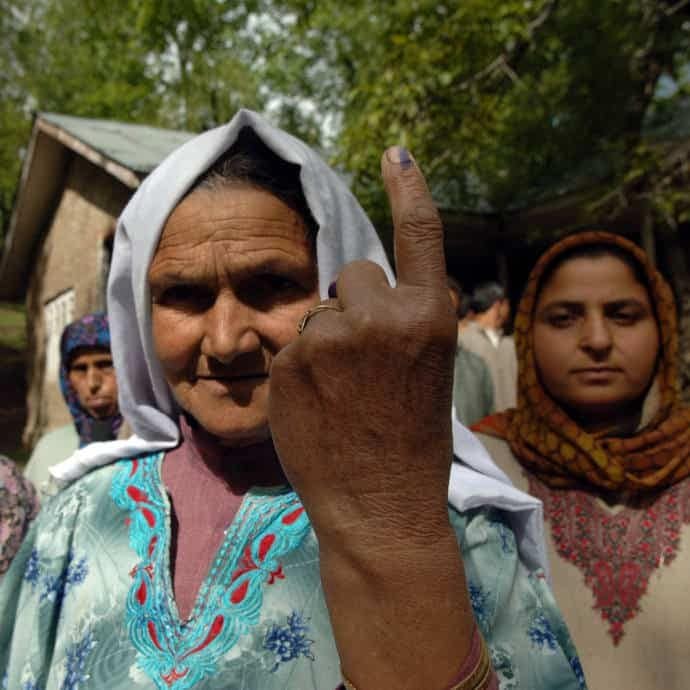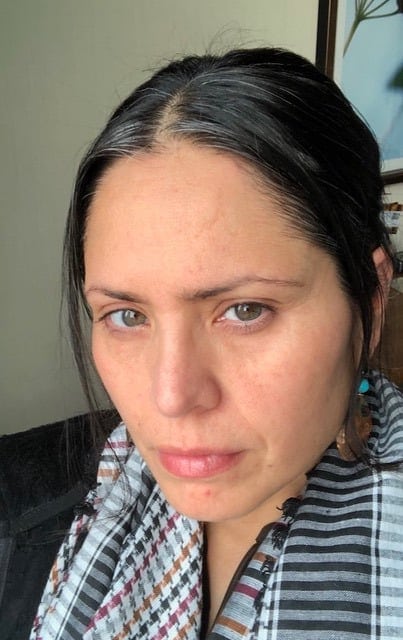This interview with Professor Ather Zia was conducted on March 31, 2018, at the University of Michigan (UM) where she delivered a keynote at a Women of Color poetry event organized by UM graduate students. The interview was conducted by UM doctoral students Salman Adil Hussain (SH), Swarnim Khare (SK), and Mary Pena (MP). The interview was transcribed by Salman, and edited by Dr. Tapsi Mathur. It was revised by Professor Zia in February 2019.
- MP: Let’s start with talking about your work in both ethnography and poetry, and how you merged the two genres, and how the devices from the two can speak to each other. Processually speaking, how do you use poetic devices in your ethnographic work or how your ethnographic research and sensibility inform your poetry?
AZ: I came to anthropology from a journalism and media studies background, and quickly became focused on anthropological theory to the extent that I feared losing my other modes of expression. To not lose these other avenues, I forced myself to make time. I founded KashmirLit in 2007-08 to provide me with one such avenue. The idea behind KashmirLit was to channel the prodigious Kashmiri poetic output out there. It isn’t an exaggeration to say that every other Kashmiri writes poetry, particularly about repression and life under occupation by India. Still, I felt that I was becoming apologetic about my poetry, and guilty that I should be doing Anthropology. Then when I went to Kashmir for fieldwork I noticed that I was writing more poetry than I was fieldnotes. It was when I became affiliated with the Society for Humanistic Anthropology that I saw people who were doing both: theoretical work as well as unapologetically pursing other literary modes of expression. People such as Renato Rosaldo, whose writing I admire a lot, gave me hope.
I don’t buy into the dichotomy between creative writing and social science research. The latter, too, is creative.
Yet, there is also the question of ethnographic surfeit, the subject of my forthcoming paper: What do you do with all that doesn’t neatly fit into fieldnotes, all that excess, of emotions, perceptions, and experiences? I channel this excess through poetry. The problem is of creating a space for it in academic representational forms and fora. While I intersperse my ethnography with poetic pieces, that alone does not quite cut it. To task the ethnographic reader with absorbing all that excess, the surfeit of emotions is to ask too much from the reader, but one had to still do it. Poetry helps the researcher as well, at least it did me, in that it is cathartic and helped me process my work. What my ethnographic research partners were telling me about Kashmir, about the trauma of occupation, was also, in a way, poetry. So, poetry has many uses, but we, as academics, worry that nonstandard creative modes of expression may hinder our careers and job prospects. I feel that we need to tell anthropologists who want to work in other forms of expression and representations, in creative writing, and in creative ethnography that there is a place and space for them, too.
- SH: If I may ask a follow up question: How do you conceive of the genre of ethnographic poetry? How do you distinguish that from ordinary poetry? To put it another way, what’s ethnographic about this poetry that’s not about other poetry?
AZ: Well, several people have offered definitions of ethnographic poetry, such as Renato Rosaldo, Melisa Cahnmann-Taylor and Adrie Kusserow, amongst the ones that I have read closely; but let me give it a shot. Ethnographic poetry is what comes out of the field, from your experience in the field that’s very visceral—in broad terms, that’s how I conceive of it. What makes it different from regular poetry is that it is really grounded in your ethnography. So, my poetry is centered on Kashmir, where I do my research, in such a way that a poem and a chapter from my ethnography will reflect each other. Alongside my ethnographic monograph, I’m working on a book of poems, titled Field In Verse, a play on the word ‘inverse’. This book is enactment and ethnographic surfeit.
There are other ways that you can play, anthropologically-speaking, with this genre. For example, in 2014, Melisa Cahnmann-Taylor, another anthropologist-poet, Nomi Stone, and I experimented with theorizing the idea of enactment. The idea was to take a social science theory, ground it in our field experience, and write a poem around it. We did an event on ‘enactments’ at the Society of Humanistic Anthropology. But, here’s the thing: if you walked into that event, you wouldn’t think that what you were hearing was ethnographically grounded, you’d think this was just poetry. But the process of making those poems was theoretically informed, and productive of theory. For instance, the first poem in Melisa Cahnmann-Taylor’s Imperfect Tense is titled “Whorfian Hypothesis.” The Sapir-Whorfian hypothesis is pivotal to a lot of linguistic anthropology. This was an example of the poetic enactment of theory in action.
I’ll say it again – there are anthropologists who express themselves in poetry and creative ethnography. Margret Mead, Ruth Benedict, they all wrote poetry but this poetry was marginalized by the discipline. Some of us at Society for Humanistic Anthropology are engaged in reclaiming this as an anthropological tradition.
- SH: Could you talk a little bit about your forthcoming monograph?
AZ: Sure! The book is titled Resisting Disappearance: Women’s Activism and Military Occupation in Kashmir. As I said, in Kashmir I worked with the APDP activists, mainly wives, mothers, and in some cases, daughters of the disappeared Kashmiri men. APDP, was co-founded by Parveena Ahangar, popularly referred to as the Iron Lady of Kashmir for resisting the abuses of the Indian Occupation. Women like her are now the face of the human rights movement in Kashmir. This has been a gradual change, over a 33-year period, from the face of resistance being men and the image of resistance being associated with conservatism. Whether women’s resistance has been able to create a seat at the table remains to be seen but things are looking up, going by the fact that organizations like APDP are regionally and internationally well recognized, as Parveena’s recent award of the Rafto Prize for Human Rights shows. This success is mostly symbolic, although very important in its own right, in that it has gained the Kashmiri cause and Kashmiri women some visibility, but things on the ground have not changed for the cases of the disappeared men, and the political status quo remains. This is largely due to the paralysis imposed by the Indian judiciary through the means of India’s Armed Forces Special Powers Act (AFSPA), whereby the Indian Army can kill, wound, maim anyone in Kashmir (and other “disturbed areas”) without accountability. AFSPA gives the Indian Army authorization to do whatever they want with impunity, and that’s how the frequent disappearances occurred in the first place.
The institutional and systemic violence has been so relentless that none of the disappeared have been found so far, and their cases have been languishing in the judicial system.
Even in such a context, and with a lack of funding, APDP and other organizations are doing what they can. This gendered resistance in Kashmir is at the heart of my book. I also analyze the frames through which Kashmir is understood as a “dispute” and how we Kashmiris see the issue and our situation. As a Kashmiri, I feel the native perspective is so ignored because of the hegemony of the Indian narrative. Kashmiris are doing all the dying. They are neither seen nor heard.
- SK: Speaking of symbolism, you’ve written about Afzal Guru and his execution for attacking the Indian Parliament. Could you tell us about your work on that trial?
AZ: The chapter analyzing Afzal Guru as symbolic of a killable Kashmiri body is published in a volume I helped co-edit titled Resisting Occupation in Kashmir. Afzal Guru was formerly a militant and he had given up arms and was later framed in a conspiracy case. This chapter analyzes how the Kashmiri man Afzal was constructed as killable, particularly by the Indian media. The concept of killable body originally emerged from my work on the disappeared Kashmiris and it developed through Agamben’s work on homo sacer. So, I wrote about how Guru was portrayed as a terrorist “body” in custody, wearing a keffiyah, a beard, and dressed in a Pathan suit, so to speak—in short, the stereotype Muslim terrorist in Indian imagination; the media might as well have put a noose around his head on screen. That’s precisely how Kashmiris are portrayed and constructed in media accounts, and that’s how the Indian Supreme Court could say that this man has to be killed to ease the collective conscience of the nation.
I also looked at his life before the attack on Parliament for which Guru was imprisoned. This was important for me to understand how the Counterinsurgency Grid—a constellation of the Indian Army and its mostly surrendered militant irregulars, police, and army-backed Ikhwani militias (armed sub-contractors, petty criminals and extortionists), the bureaucrats and top brass overseeing this network—constructed him. They say that Guru was trained in Pakistan, but, from my perspective, he didn’t go to Pakistan; he went to Azad Kashmir, or Pakistan-held Kashmir, the Kashmir on the other side of the border. Once he returned and surrendered, he was monitored by the Grid, after which he couldn’t carry on with his day to day life and had to report to the police and Indian Army every day. In Kashmiri parlance, the militants who put down arms and surrender are called cylinders or cylinder militant, because surrender and cylinder sound similar. It’s thus a colloquial word used to describe such militia. Arundhati Roy discusses in an essay how Guru was caught in the web of the Counterinsurgent State, and how the Grid made him into a scapegoat even in the face of evidence to the contrary and a lack of evidence linking Guru to the attack of Indian parliament, the so-called heart of Indian democracy. Guru, to me, underscores the meaning of the icon of the Kashmiri as a body that could be killed with impunity and without questions or consequences. One can compare this case with the much older case of Maqbool Bhatt, who was killed similarly. In my view, the increased penetration of news and other media outlets in Indian society at the time of Guru’s trial played a key role in constructing him as a body that needed to be sacrificed to placate the nation. Both Bhatt and Guru are buried inside Tihar jail. The Indian government did not return their bodies to their family. On the other hand, Kashmiris have reserved two open graves in Kashmir’s martyrs graveyard, symbolic of waiting for their remains.
- SK: Could you tell us about the scholarship your work is in conversation with, particularly with respect to Kashmir, and what exciting work to watch for?
AZ: There are a few Kashmiri scholars who are doing very meaningful work around Kashmir and thinking about decolonial feminist praxis and soldarities. There’s Mona Bhan, political anthropologist; Haley Duschinsky, a legal anthropologist at Ohio University; Deepti Misri, literary and cultural critic; and historian Hafsa Kanjwal — all of us got together and founded Critical Kashmir Studies. We found that scholarship from Pakistan or India mainly takes on questions that append Kashmir to either of these states. Critical Kashmir Studies counters that and centers Kashmir through “native” voices and perspectives, providing a platform to talk about Kashmir the way Kashmiris want to. Other than these kindred spirits, there is Suvir Kaul; Nitasha Kaul, who also publishes in mainstream media outlets; Inshah Malik whose book on Kashmiri women in resistance was just released; and the Delhi-based researcher, Seema Kazi, who has worked on gender in Kashmir. There is Cabeiri Robinson, who works on Kashmir from the Pakistani side and provides the kind of knowledge that Kashmiris like me, on the other side of the border, might not know. Then there is journalism, such as Freny Manecksha’s book on women’s resistance, Behold, I Shine, whose title harks back to the medieval poetess Habba Khatun. Also, we have a Special Issue of EPW [now out], featuring quite a few Kashmiri women writers, edited by Kashmiri women (Nitasha Kaul and I). On the Critical Kashmir Studies website, we’re creating bibliographies on Kashmir, and planning to create syllabi for potential future courses on Kashmir.
Featured image by Public.Resource.Org (flickr, CC BY 2.0)








2 Comments